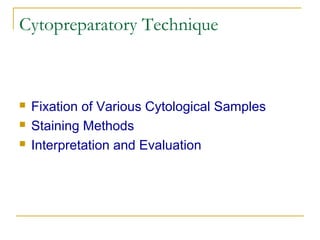General 1 fixatives cytology
•Descargar como PPT, PDF•
43 recomendaciones•32,025 vistas
Denunciar
Compartir
Denunciar
Compartir

Recomendados
Más contenido relacionado
La actualidad más candente
La actualidad más candente (20)
COMPARISON OF CONVENTIONAL PAPANICOLAOU STAIN WITH MODIFIED ULTRAFAST PAPANIC...

COMPARISON OF CONVENTIONAL PAPANICOLAOU STAIN WITH MODIFIED ULTRAFAST PAPANIC...
Staining ( rouine and special in cytology) rajiv kumar

Staining ( rouine and special in cytology) rajiv kumar
Similar a General 1 fixatives cytology
Similar a General 1 fixatives cytology (20)
Practical histopathology and cytopathology dr.ameer

Practical histopathology and cytopathology dr.ameer
Histological Techniques: Perform Fixation and Tissue Processing

Histological Techniques: Perform Fixation and Tissue Processing
Histopathological techniques -sectioning, STAINING, EMBEDDING, fixaton, micro...

Histopathological techniques -sectioning, STAINING, EMBEDDING, fixaton, micro...
lecture3andlecture4techniquesincellbiology-210201105723.pdf

lecture3andlecture4techniquesincellbiology-210201105723.pdf
Último
Último (20)
Integrated Neuromuscular Inhibition Technique (INIT)

Integrated Neuromuscular Inhibition Technique (INIT)
Renal Replacement Therapy in Acute Kidney Injury -time modality -Dr Ayman Se...

Renal Replacement Therapy in Acute Kidney Injury -time modality -Dr Ayman Se...
Vaccines: A Powerful and Cost-Effective Tool Protecting Americans Against Dis...

Vaccines: A Powerful and Cost-Effective Tool Protecting Americans Against Dis...
Cardiovascular Physiology - Regulation of Cardiac Pumping

Cardiovascular Physiology - Regulation of Cardiac Pumping
Introducing VarSeq Dx as a Medical Device in the European Union

Introducing VarSeq Dx as a Medical Device in the European Union
Book Trailer: PGMEE in a Nutshell (CEE MD/MS PG Entrance Examination)

Book Trailer: PGMEE in a Nutshell (CEE MD/MS PG Entrance Examination)
TEST BANK For Huether and McCance's Understanding Pathophysiology, Canadian 2...

TEST BANK For Huether and McCance's Understanding Pathophysiology, Canadian 2...
Muscle Energy Technique (MET) with variant and techniques.

Muscle Energy Technique (MET) with variant and techniques.
Denture base resins materials and its mechanism of action

Denture base resins materials and its mechanism of action
TEST BANK For Timby's Introductory Medical-Surgical Nursing, 13th Edition by ...

TEST BANK For Timby's Introductory Medical-Surgical Nursing, 13th Edition by ...
Cas 28578-16-7 PMK ethyl glycidate ( new PMK powder) best suppler

Cas 28578-16-7 PMK ethyl glycidate ( new PMK powder) best suppler
General 1 fixatives cytology
- 1. Cytopreparatory Technique Fixation of Various Cytological Samples Staining Methods Interpretation and Evaluation
- 2. Fixation and Fixatives Fixation is the basis or foundation of cytological technique and the results of all subsequent procedures depend on the correct selection and use of the fixative employed. It is a complex series of chemical events and differs for the different groups of chemical substances found in the tissues
- 3. Fixation and Fixatives Fixation is the basis or foundation of cytological technique and the results of all subsequent procedures depend on the correct selection and use of the fixative employed. It is a complex series of chemical events and differs for the different groups of chemical substances found in the tissues
- 4. Fix , means to confine from which it can not move away or to keep in life like condition shortly after death or removal from the body. WHY FIX? To preserve cell organelles and chemical constituents in a condition identical to that existing during life .Since this aim is impossible hence methods are applied: To prevent Autolysis To prevent putrefaction (Bacterial decomposition) To fortify cells against damage for post fixation procedures e.g. Dehydration, Clearing, Embedding etc. To Facilitate subsequent staining of smears.
- 5. Fixative:“ Substance which preserves after death, the shape, structure, relationship and chemical composition of tissues and cells.” Effects of Fixation Sudden death of Tissues but preserves the structure. Coagulation of proteins Prevents diffusion of substances Hardens tissues –prevents from shrinkage or swelling Changes refractive index Facilitates action of dyes in staining Prevents autolysis and bacterial putrefaction
- 6. Qualities of Good Fixative A good fixative should be capable of fulfilling the following requirements:(1) It must kill the cell quickly without shrinking, swelling, or other distortion. (2)It must penetrate the tissue and cells rapidly and evenly. (3) It must render insoluble substance of the cell and give good optical differentiation. (4)It must harden the tissue and render it insensitive to subsequent treatment.
- 7. Qualities of Good Fixative (5)It must permit at a later date the application of numerous staining procedures. (6)It must inhibit bacterial decay and autolysis. (7)It should allow tissue to be stored for long period of time. (8) It should permit the restoration of natural color for photography and mounting as museum specimens. (9) It should be simple to prepare and economical in use.
- 8. Classification of Fixatives Can be divided into two main groups:(A) Simple Fixative:•Aldehyde: - Formaldehyde, Gluteraldehyde, Acrolein,Glyoxal •Oxidizing Agents: - Osmium tetroxide, Pot. permanganate, Pot.dichromate •Protein –Denaturing Agent or Coagulant :- Acetic acid, Methyl alcohol, Ethyl alcohol •Others: - Mercuric chloride, Picric acid, Non – aldehyde containing fixative
- 9. (B)Compound Fixative (I) Micro anatomical Fixative :•10% Formalin •10% Formal Saline •10% Buffered formalin •10% Formal Calcium •Heidenhain’s susa •Zenker Fluid • Bouin’s Fluid •Gender’s Fluid (ii) Cytological Fixative :(a)Nuclear Fixative :•Carnoy’s Fluid •Clarke’s Fluid •Alcohol Formalin (b)Cytoplasmic Fixative :•Champy’s Fluid (c)Histochemical Fixative :•Buffered Formalin •Cold Acetone •Abs. alcohol
- 10. Classification of Fixatives (iii) Other Methods of Fixation •Vapour Fixation •Heat Fixation •Freeze drying etc
- 11. Cytolological Fixatives:Alcohols:- Specifically recommended for cytological preparation (1)95% Ethanol/Ethyl alcohol (2)95 %Rectified Spirit (3)100% Methanol (4) Isopropyl alcohol/propanol (5) Alcohol Ether (1:1)
- 12. Other Fixatives (1) Schaudinn’s Fluid :.Aqs.Mercuric Chloride-66ml .Abs. Ethyl Alcohol-33ml .Glacial Acetic Acid-1ml (2)Carnoy’s Fluid :.100% Ethanol-60ml .Chloroform-30ml .Glacial Acetic Acid-10ml
- 13. Fixatives (3)Cabowaw Fixative:.Carbowax-3.0gm .Glacial Acetic Acid-0.2ml .Abs. Alcohol-100ml (4) Aerosol Spray Fixative :-
